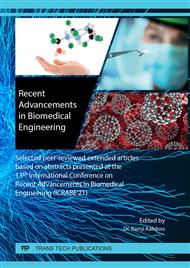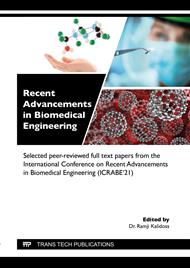[1]
K. Radhakrishanan, P. Panneerselvam, A. Ravikumar and N. Morad, Magnetic core-shell fibrous silica with functionalized pyrene derivatives for sensitive and selective detection of Hg (II) ions,, J. of Dispers. Sci and Technol, 40, (2019) 1368–1377.
DOI: 10.1080/01932691.2018.1468265
Google Scholar
[2]
N. V. Saranchina, A. A. Dudkina, M. M. Gavrilenko, N. A. Gavrilenko, A Simple Method for Colorimetric and Naked-Eye Detection of Mercury in Fish Products, Mater. Sci. Forum., 970 (2016) 219-226.
DOI: 10.4028/www.scientific.net/msf.970.219
Google Scholar
[3]
Y. J. Long, Y. F. Li, Y. Liu, J. J. Zheng, J. Tang, C. Z. Huang, Visual observation of the mercury-stimulated peroxide mimetic activity of gold nanoparticles, Chem.Commun., 47 (2011) 11939-11941.
DOI: 10.1039/c1cc14294a
Google Scholar
[4]
M. Asra, A. Zara, S. M. Raza, Colorimetric sensing of mercury ions in aqueous solutions by zinc core-shell nanoparticles, Sensor letters, 8 (14) (2016) 800-807.
DOI: 10.1166/sl.2016.3705
Google Scholar
[5]
K. Morakchi, A. Zazoua, A. Hamel, S. Zougar, R. Kherrat, N. Jaffrezic-Renault, Functionalization of ISE Sensor for Metal Ion Detection, Mater. Sci. Forum., 609 (2009) 249-254.
DOI: 10.4028/www.scientific.net/msf.609.249
Google Scholar
[6]
Y. J. Long, Y. F. Li, Y. Liu, J. J. Zheng, J. Tang, C. Z. Huang, Visual observation of the mercury-stimutated peroxidase mimetic activity of gold nanoparticles, Chem. Commun., 47 (2011) 1939-11941.
DOI: 10.1039/c1cc14294a
Google Scholar
[7]
Y. Wan, P. Qi, D. Zhang, J. Wu, Y. Wang, Manganese oxide nanowire-mediated enzyme-linked immunosorbent assay, Biosens. Bioelectron., 33 (2012) 69-74.
DOI: 10.1016/j.bios.2011.12.033
Google Scholar
[8]
L. Burratti, E. Bolli, M. Casalboni, F. de Matteis, F. Mochi, R. Francini, S. Casciardi, P. Prosposito, Synthesis of Fluorescent Ag Nanoclusters for Sensing and Imaging Applications, Mater. Sci. Forum., 941 (2018) 2243-2248.
DOI: 10.4028/www.scientific.net/msf.941.2243
Google Scholar
[9]
M. Yoon, R. Srirambalaji, K. Kim, Homochiral metal-organic frameworks for asymmetric heterogeneous catalysis, Chem. Rev., 112 (2012) 1196-1231.
DOI: 10.1021/cr2003147
Google Scholar



